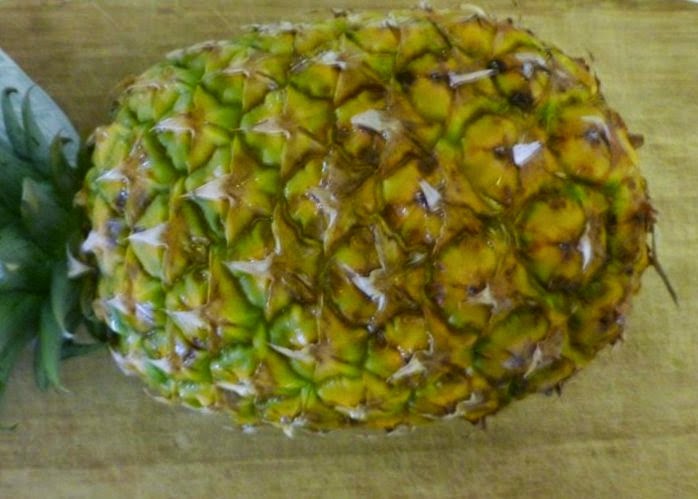My friend Karen has a suggestion.
"Hey, how about taking a break from writing about weirdo fruits and bizarre vegetables and write instead about something practical, like how to choose a good melon or cut up a pineapple? You know, something useful?"
Hey, I'm all about useful and practical. Was not this blog's very first entry Make It Pretty about making attractive fruit platters?
But Karen is right that I have digressed from time to time from this Useful 'n' Practical path, so I will try to heed her advice. December isn't the best time for melon tips, but it's always pineapple importing season in New York.
What should you look for in a fresh pineapple? First, you want a nice, tropical scent. Avoid pineapples with no scent, which are likely to be under-ripe and flavorless, or with fermented or rotten scents. Also avoid pineapples that are predominantly green. A bit of brown may be okay - it was in the pineapple shown above - provided the brown areas aren't spongy, soft or bruised. I personally haven't found the pull-out-a-leaf method (if the leaf releases easily, the pineapple is ripe - or overripe) helpful in determining flavor, but it is kind of fun. Just make sure you leave some leaves on for the next tester.
Now you're ready to cut up your pineapple. For about $20 you could buy a gadget that cores and slices the pineapple. Like leaf-pulling, using this tool is kind of fun. If it takes the intimidation factor out of enjoying fresh pineapple, great. On the other hand, the corer does waste a fair amount of the pineapple, and it's one more item to buy and maintain. It's not hard to cut up a pineapple using one of those nice sharp knives that you ideally already have on hand. I use my my trusty chef's knife.
1) Cut the bottom of the pineapple off. Some people cut off the crown at this stage, but I like to keep the crown as a handle.
2) Stand the pineapple up and begin cutting off the peel. Don't worry if you leave some peel or "eye" in place. You'll be going back and correcting your work.
3) Find the diagonal line on which a collection of eyes fall. Make a cut to the right of this line.
4) Then make an angled cut to the left of the eyes and remove a V shaped chunk of eyes.
5) Repeat throughout the pineapple.
6) Vive la Revolution! It's time to cut off the crown.
7) Interestingly, the V cuts end up being a bit decorative.
8) Cut the pineapple in half, then quarters.
9) Remove the woody core. Frugalistas can use the core to make fruit vinegar, stock and skin treatments.
10) And after that, it's off to the fruit platter. Note the decorative fins your V cuts have given your pineapple slices!
A nice change of pace from the lifesaver ring shape.


















.jpg)








.jpg)

.jpg)




















.jpg)
